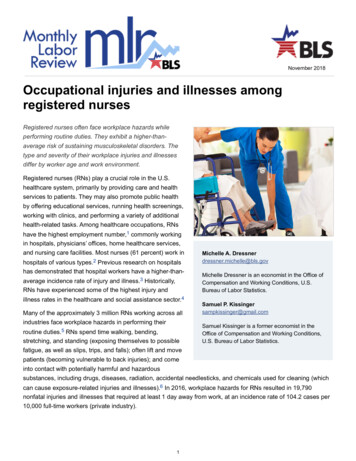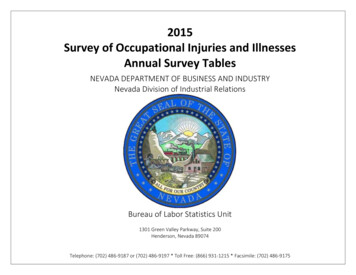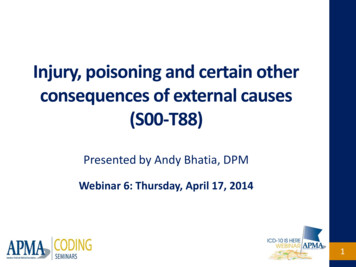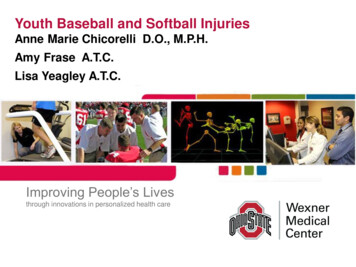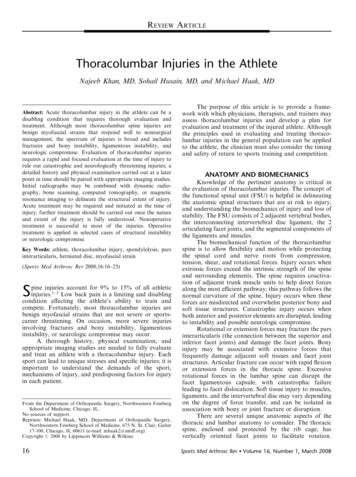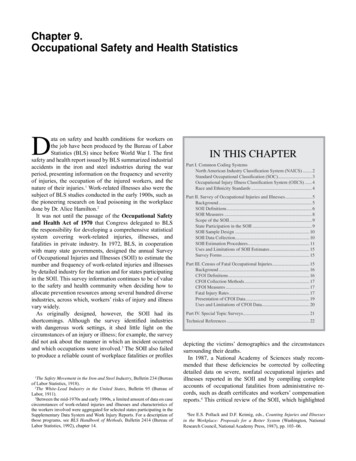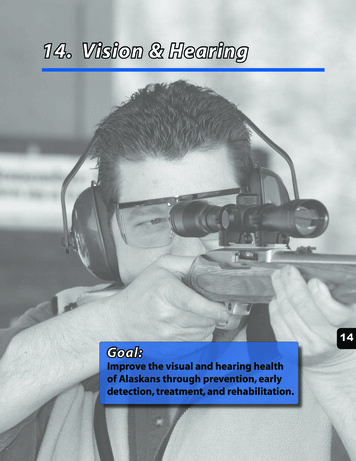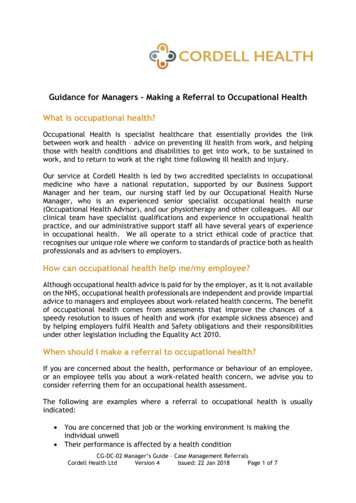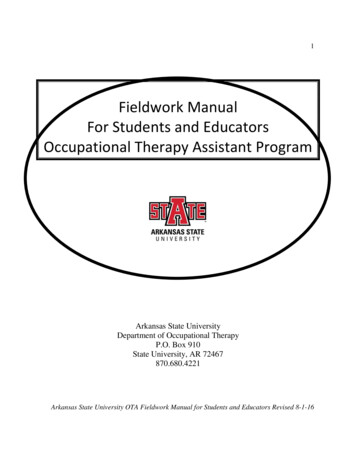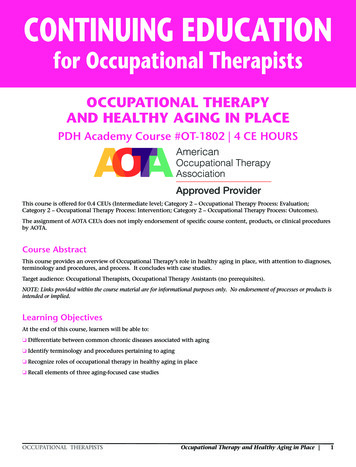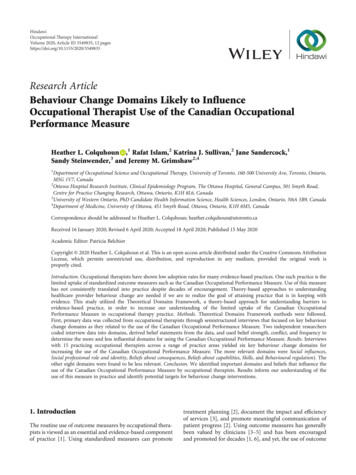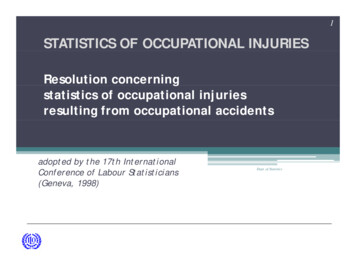
Transcription
1STATISTICS OF OCCUPATIONAL INJURIESResolution concerninggstatistics of occupational injuriesresulting from occupational accidentsadopted by the 17th InternationalConference of Labour Statisticians(Geneva, 1998)Dept. of Statistics
2Why do we want information aboutoccupationalil iinjuries?j i ?International Labour OfficeÓto prevent them happening:x to identify occupations and economic activitieswhere occupational accidents occurx to set priorities for preventive effortsx to detect changes in patterns and occurrencesx to inform employers and workers of risksassociated with their work and workplacesx to evaluate effectiveness of preventivemeasures
3Objectives of the resolutionDept. of Statistics Primary: to provide basic guidance forcollection and presentation of statistics ofoccupational injuries at the national level,for countries wishing: to revise existing statistical systems, or to establishbli h new statisticali i l systems Secondary: to enhance internationalcomparability
4Other ILO statistical standards relatingto occupationalil iinjuriesj iDept. of Statistics Protocol to the OccupationalpSafetyy and HealthConvention, 1981 (2002) Recommendation concerning the list ofoccupational diseases and the recording andnotification of occupational accidents anddiseases (2002) ILO Code of Practice on the Recording andNotification of Occupational Accidents andDiseases (1996)
5Dept. of StatisticsObjectives of the statistics of OImajor component of a comprehensive programme of statisticson occupational safety and health to provide comprehensive and timelyinformation for pprevention ppurposesp to meet the needs of the major users,including employers and workers
6Dept. of StatisticsCCoverage(1) all occupational injuriesÓ fatal injuriesÓ non-fatal injuries causing an absence from work of at least onedayÓ (injuries resulting from commuting accidents - compiled anddisseminated separately) all ll workers,kiincludingl di childhild workers,khhomeworkersk all economic activities and sectors, includinginformal sector whole countryÓ all persons injured within jurisdiction of country
7Coverage (2)Dept. of StatisticsNot included in the resolution, but have been found to besignificant especially in developing countries:significant, cases of restricted activity: cases of non-fatal injury notresulting in an absence from work, but which prevent thei j d workersinjuredk fromfcarryingi outt theth normall taskst k off theth jobj b orpost occupied at the time of the accident: of particular importance regarding: the self-employed workers and activities not covered by accidentcompensation schemes
8Dept. of StatisticsWhat is an occupationalpinjury?j yAny personal injury, disease or death resulting from anoccupational accident[distinct from an occupational disease: a diseasecontracted as a result of exposure over a period of timeto risk factors arising from work activity]
9Dept. of StatisticsWhat is an occupational accident?An unexpected and unplanned occurrence, including actsof violence, arising out of or in connection with work,which results in one or more workers incurring apersonal injury, disease or death[includes travel, transport and road traffic accidents inwhich workers are injured and which arise out of or inthe course off work]]
10What is incapacity to work?Dept. of StatisticsIncapacity for work: inability of the victim, due to an occupational injury,t performtoftheth normall dutiesd ti off workk ini theth jobj b or postt occupiedi d att theth timetiof the occupational accident.Cases of temporary incapacity are cases of occupational injury where theworkers injured were unable to work from the day after the day of theaccident, but were later able to perform again the normal duties of work inthe jjob or postp occupiedp at the time off the occupationalpaccident causinggthe injury within a period of one year from the day of the accident.Cases of permanent incapacity for work are cases of occupational injurywhere the persons injured were unable to work from the day of the accident,and were never able to perform again the normal duties of work in the jobor post occupied at the time of the occupational accident causing the injury.
11International Labour OfficeWhat is a fatal occupational injury?Occupational injury that resulted in death that occurredwithin one year of the day of the accident.
12Dept. of StatisticsBasic information to be collectedFor each case of occupational injury information about enterprise, establishment orlocal unit:Ó location, economic activity, size information about person injured:Ósex age,Ósex,age occupationoccupation, status in employment information about injury:Ófatal/non-fatal, type of injury, part of body injured information about accident and circumstances:Ó type of location, date and time, mode of injury, material agencyof injury
Additional data13Dept. of StatisticsFurther information where considered useful, and particularly for more seriouscases of occupational injury and fatalities information about injury:Ó incapacity for work (calendar days of absence from work) information about accident and its circumstances:Óshift, start time of work of injured person and hoursÓshiftworked in activity when accident occurredÓtotal number of workers injured in accidentÓplace of occurrenceÓwork process of injured personÓspecific activity of injured person and associated materialagencyÓdeviation resulting in accident and associated materialagency
14MeasurementDept. of Statistics Cases of fatal injury: the number of personsfatally injured as a result of occupationalaccidents, and where death occurred within oneyear of the day of the accident.accident
15Dept. of StatisticsMeasurementCases of non-fatal injury with lost work time (temporary andpermanent incapacity) Cases of permanent incapacity for work are cases ofoccupational injury where the persons injured were unable towork from the day of the accident,accident and were never able toperform again the normal duties of work in the job or postoccupied at the time of the occupational accident causing theinjury. Cases of temporary incapacity are cases of occupationalinjury where the workers injured were unable to work fromthe day after the day of the accident, but were later able toperform again the normal duties of work in the job or postoccupied at the time of the occupational accident causing theinjury within a period of one year from the day of theaccident.
16Dept. of StatisticsMeasurement Days lost by cases of temporary incapacity:the number of calendar days during whichthose persons temporarily incapacitated wereunable to work, excluding the day of theaccident, up to a maximum of one year. for cases of permanent incapacity for work and fatalities: maybe estimated, but should be compiled and disseminated separately
17Dept. of StatisticsWhat do want to do with the information?Comparative measures may be calculated for each economic activityactivity,occupation, sex, age group, etc. Frequency rate (for fatal and nonnon-fatalfatal cases) per 1’000’0001 000 000hours : the number of new cases of injury during the calendar yeardivided byy the total number of hours worked byy workers in thereference group during the year, multiplied by 1,000,000 Incidence rate (for fatal and non-fatal cases) per 100,000workers : Incidence rates calculated as the number of new cases of injuryduring the calendar year divided by the number of workers in thereference group during the year, multiplied by 100,000.
18Dept. of StatisticsComparative measures- if time lost is measured- for cases of temporary incapacity only: Severity rate(days lost per 1’000’000 hours worked): days lost as a result of new cases during the calendar yeardivided by the total amount of hours worked by workers inreference group during the calendar year, multiplied by1,000,000 Days lost per injury: median or mean number of days lost per injury during thecalendar year
19ClassificationsDept. of StatisticsUsing classification schemes that are comparable with or may be relatedto the most recent versions of the relevant international classifications by economic activity far asf as possible,ibl otherth significanti ifit characteristicsht i ti offpersons injured, of enterprises, establishments or localunits, injuries and accidents:Ó location, size of unitÓsex, age, occupation, status in employmentÓfatal or non-fatalnon fatal injury,injury type of injuryinjury, part of bodyinjuredÓtypeyp of location of accident, mode and materialagency of injury
20ClassificationsDept. of StatisticsInternational classifications: International Standard Industrial Classification of All EconomicActivities (ISIC), Rev. 3, 1990 Size of enterprise, etc.: as in International Recommendationsf IIndustrialford t i l Statistics,St ti tiRev.R1,1 1983 International Standard Classification of Occupations, ISCO-88p y, ICSE-93 International Classification of Status in Employment, Type of injury: from International Statistical Classification ofDiseases and Related Health Problems, ICD-10, 1992 Part of body injured: from ICD-10,ICD 10 1992
21Dept. of StatisticsCl ifi tiClassificationsILO should also develop and disseminate classifications toreplace or supplement existing schemes (from 10th ICLS resolution): place of occurrence work processpactivityy specific deviation material agency associated with specific activity ordeviation
22Dept. of StatisticsFurther challengesg for the ILO preparation of worldwide estimates of fataloccupationalpinjuriesj estimation of costs of occupational injuries develop standards for statistics of occupationaldiseases
23SourcesDept. of StatisticsStatistics should be based on a range of sources of information existing sources:Ó notification systems (labour inspection, compensation)Ó other administrative records (hospitals, employers’/workers’organizations)Ó surveys (establishment surveys, household surveys) development of new sources to supplement existingones concepts, definitions, coverage and classificationsused by different sources must be consistent:Ó national coordinating committeeÓ harmonization of statistics from different sources
24International Labour OfficeSources of data on occupationalinjuries/diseases Labour inspectorate records: notified cases, days lost Compensation schemes: cases for which claimssubmitted / compensation paid, days lost Labour force surveys: non-fatal cases, days lost Establishment surveys: reported cases (fatal / nonfatal), days lost, costs
25International Labour OfficeLimitations Labour inspectorate records and Compensationschemes coverage (workers, economic activities, sectors,establishments,t bli ht geographichi areas, occupationaltilaccidents, occupational diseases) quality of reported data (concepts) reference population time lag quality of data produced
26International Labour OfficeLi it tiLimitations Labour force surveysy coverage (only non-fatal cases) sample size proxy response,response recall errors,errors subjectivity ofconcepts response rate EstablishmentE t bli ht surveys Coverage (formal sector only)employers'p yrecordsresponse ratetime lag
Classifications Dept. of Statistics 20 International Standard Industrial Classification of All Economic International classifications: Activities (ISIC), Rev. 3, 1990 Size of enterprise, etc.: as in International Recommendations f I d t i l St ti ti R 1 1983for Industrial Statistics, Rev. 1, 1983
